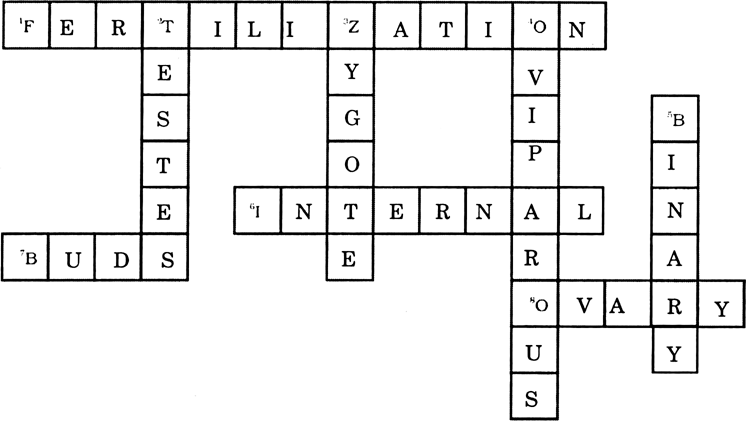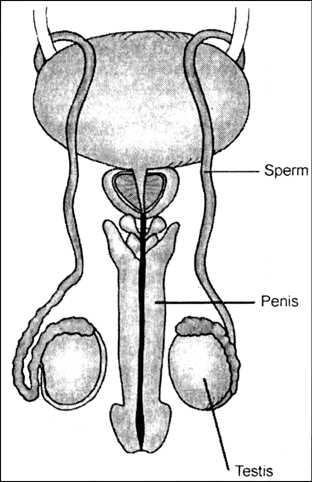Science Chapter 9 Reproduction In Animals
Sponsor Area
NCERT Solution For Class 8 Social+science
Explain the importance of reproduction in organisms.
Reproduction is an important process as it ensures the continuation of similar kinds of individuals, generation after generation.
Describe the process of fertilisation in human beings.
The fusion of male and female gamete is called fertilization. Internal fertilization takes place in humans. Male releases sperms inside female’s body. Sperms and ovum fuse together in fallopian tube, during fertilization, the nuclei of the sperm and the egg fuse to form a single nucleus. This results in the formation of the zygote.
Give two differences between a zygote and a foetus.
|
Zygote |
Foetus |
|
1. It contains only one cell. 2. It is formed by the fusion of ovum and sperm. |
1. It contains many cells. 2. It is formed by repeated divisions of zygote. |
Define asexual reproduction. Describe the two methods of asexual reproduction in animals.
Asexual reproduction is that type of reproduction in which only single parent is involved. It takes place by different methods like budding, binary fission etc.
(i) Budding : In this type of reproduction new individuals develop from the buds. For example - reproduction in hydra.
(ii) Binary fission : In this type of reproduction, a single organism gets divided into two. This type of reproduction takes place in Amoeba. The nucleus of the Amoeba divides into two, followed by division of their bodies, each part getting one nucleus and developing into separate individual.
Sponsor Area
What is metamorphosis? Give examples.
Metamorphosis is the transformation of the larva into an adult through drastic changes.For example the transformation of a caterpillar into a butterfly is called metamorphosis.
Differentiate between internal fertilization and external fertilization.
The differences between internal fertilization and external fertilization are:
i. Internal fertilization takes place inside the body of the female while the external fertilization takes place outside the body of the female.
ii. In case of internal fertilization sperms are ejaculated in female’s body by the male. In external fertilization sperms are discharged outside the body of the female.
Define sexual reproduction.
Reproduction in which a male and female are involved is called sexual reproduction. In this mode of reproduction the male and female gametes fuse together.
Define asexual reproduction.
Asexual reproduction is the mode of reproduction in which only a single parent is involved.
What is the name of the reproductive process :
(a) Which involves only one parent?
(b) Which involves two parents?
(a) Asexual reproduction.
(b) Sexual reproduction.
What is fertilization?
Fertilization is the fusion of male and female gametes to form a zygote.
Name female reproductory organs.
The reproductive organs in the female include
ovaries, oviducts and uterus.
Name male reproductory organs.
The reproductive organs in male include testes, sperm ducts and penis.
Name the kind of fertilization which takes place inside females body. Give an example of organism in which it takes place
Internal fertilization is the fertlization which takes place inside females body. This type of fetilization takes place in humans.
Where does an embryo grow in case of external fertilization?
In case of external fertilization the fertilization takes place outside a female's body.
Sponsor Area
Give two examples of viviparous animals.
Humans and cows are viviparous animals hich give birth to young ones.
What do we call the sudden and extreme changes taking place during the development of an animal?
The sudden and extreme changes taking place during the development of an animal is called metamorphosis.
Name any two methods of asexual reproduction.
Budding and binary fission are two methods of asexual reproduction.
Do we also undergo metamorphosis?
No, we do not undergo metamorphosis. There is no drastic change in humans. In human beings, body parts similar to those present in the adults are present from the time of the birth. Therefore, we do not undergo metamorphosis.
What is cloning?
Cloning is the production of an exact copy of a cell, any other living part or a complete organism. For example, production of the clone sheep - Dolly by Ian Wilmut and his colleagues.
What is reproduction? Why is it important?
Reproduction is giving birth to organisms of same kind. Reproduction is important to continuity of species on earth and to maintain different special characters of different species. It ensures the continuation of similar kinds of individuals, generation after generation.
What are different modes of reproduction?
Reproduction takes place by two methods. Asexual and sexual mode.
Inasexual mode of reproduction, a single parent is involved. For exmaple - reproduction in amoeba and hydra.
In sexual mode of reproduction, male and female i.e. both parents are involved in the process of reproduction. For example - reproduction in humans.
What are the names of male reproductory organs in human beings?
In human beings male reproductory organ consists of are a pair of testes, sperm ducts and a penis. Testes are responsible for producing male gametes called sperms.
Explain the reproductory organs of female in human beings.
In human beings the female reproductory organ consists of a pair of ovaries, oviducts or fallopian tubes and the uterus. Ovaries produce female gamete called ova, which fertilize with male sperm in female fallopian tube and travels to uterus for further development.
What is fertilisation? Show the diagram also.
Fertilisation is the fusion of male and female gamete form a zygote. When the male gamete (sperm) enters the female ova , the nucleus of the sperm fuses with nucleus of the ova to form a single nucleus. This results in the formation of the fertilised egg or the zygote.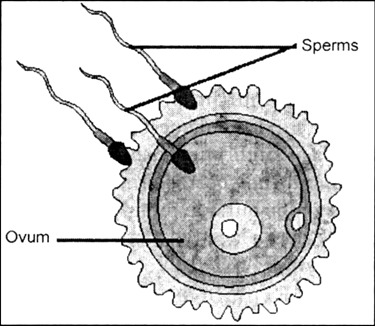
Describe the human male and female gametes.
In human beings the males produce the male gamete called sperms. Sperms which is a single cell is very small in size. it has three parts - a head, a middle piece and a tail.
The female gamete called ova or egg is produced by ovaries. Every ova is a single cell. One matured ova is released by one of the ovaries every month.
How does a new born baby have characters of both his father and mother?
In sexuaal reproduction the gamete from the father and the gamete from the mother, fuse to produce the zygote. This zygote develops into baby. Since it involves the fusion of gamete of bothe the parents, thus, the baby depends both hi father and mother.
What is fertilization? Explain how many types of fertilizations are there?
Fertilizations is the fusion of male and female gamete to form zygote. There are two types of fertilization :
i. Internal fertilization - is the fertilization in which the male releases his sperms into the body of the female and fertilization takes place inside the female body. For example fertilization in human beings.
ii. External fertilization - is when the male and female release their gametes out in open and fertilization occurs outside the female body. For example -fertilization in frog and fish.
What do you mean by test-tube baby?
Babies born through the technique of in vitro fertiliztion are called test-tube babies. In in vitro fertilisation, freshly released egg and sperms are collected and kept together for a few hours in a test tube for fertilization. After fertilization , the zygote formed is allowed to develop for a week and then is placed inside the mother's uterus where further development takes place.
Explain how external fertilization takes place?
In external fertilization, the females lays hundreds of eggs outside in places like streams. The eggs are kept together and protected by a layer of jelly. The male deposits sperms over the eggs resulting in the fertilization.
What is budding? Draw the diagram also.
Budding is an asexual method of reproduction in animals. Only a single parent is involved in reproduction. The body of the animal starts developing a small outgrowth called bud which gives rise to a new individual. Animals like hydra reproduce through budding.
What do you mean by binary fission? Draw a diagram also.
Binary fission is a method of asexual reproduction. In this method the body of the animal divides into two halves. The nucleus divides into two, followed by the division of the whole body. It gives rise to two individuals. Amoeba reproduce by binary fission.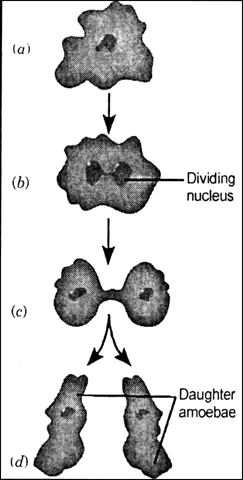
How does the embryo get nourishment inside the mother’s body?
Embryo gets nourishment from mother’s body with the help of placenta through a cord called umbilical cord. Placenta contains many finger-like villi from the chorion covering of the embryo. This occurs in contact with blood sinuses of the mother present in the endometrial lining of uterus. All nutrients (glucose, amino acids, vitamins, etc.) diffuse from mother’s blood into villi and from there to embryo through the umbilical cord.
Two very small organisms X and Y both reproduce by the method of budding. Organism X is industrially very important because it is used in making alcohol from sugar. It is also used in making bread. Organism Y is a tiny animal having tentacles which lives in water.
(a) What is organism X?
(b) Name the process in which X converts sugar into alcohol.
(c) To which class of organism does X belong?
(d) What is organism Y?
(e) Out of X and Y, which organism is multicellular and which one is unicellular?
(a) Yeast.
(b) Fermentation.
(c) Fungi.
(d) Hydra.
(e) Multicellular : Y (Hydra), Unicellular :X (yeast).
(i) What is fertilisation?
(ii) Name the type of fertilisation in human.
(iii) Where does it mainly occur?
(iv) How does fertilisation take place in human female?
(i) Fertilisation is the fusion of a male gamete (sperm) and a female gamete (ovum or egg) to form of zygote during sexual reproduction.
(ii) The type of fertilization that takes place in in humans is internal fertilisation.
(iii) Fertilization occur in the fallopian tubes of the female reproductive system.
(iv) When tha male gamete or sperm reaches the female gamete ova, one of the sperms fuses with the egg leading to fertilization. The nuclei of the sperm and the egg fuse to form a single nucleus. This results in the formation of a fertilized egg or zygote.
Draw and describe the male reproductive organs in humans.
Male reproductive organs consist of a pair of testes, sperm ducts and penis. Testes are responsible for producing male gamete called sperm. Testes produce the male hormone testosterone. 
Draw and explain the female reproductive organs in humans.
Female reproductive organs consist of a pair of ovaries, oviduct or fallopian tubes and uterus. Ovaries produce the female gamete called Ova. Every month an ovary produces an ovum. The ovum and sperm fertilize inside fallopian tubes and the fertilized zygote travels to the uterus and attach with its wall to develop into the foetus.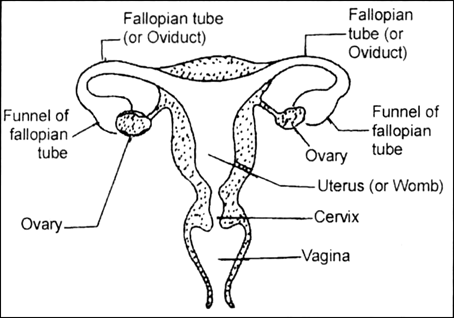
How are the young ones of frogs and other aquatic animals produced?
Frogs and many other aquatic animals lay their eggs and sperms in water. Females lay eggs in slow moving streams. The males also lay their sperms on the eggs. Eggs and sperms are produced in a very large amount because most of these get scattered away due to water, wind and rains. only a few come in contact with each other and get fertilized. They divide and grow into tadpoles.
Sponsor Area
Match the following option:
| A. Amoeba | (i) asexual reproduction |
| B. Yeast | (ii) binary fission |
| C. Single parent | (iii) budding |
| D. Tadpole | (iv) Ovum |
| E. Ovary | (v) metamorphosis |
A. Amoeba | (i) binary fission |
B. Yeast | (ii) budding |
C. Single parent | (iii) asexual reproduction |
D. Tadpole | (iv) metamorphosis |
E. Ovary | (v) Ovum |
Match the following option:
| A. Frogs | (i) Give birth to young ones |
| B. Testes | (ii) Metamorphosis |
| C. Viviparous | (iii) Sperms |
| D. Internal fertilization | (iv) Lay eggs |
| E. Oviparous | (v) Human being |
A. Frogs | (i) Metamorphosis |
B. Testes | (ii) Sperms |
C. Viviparous | (iii) Give birth to young ones |
D. Internal fertilization | (iv) Human being |
E. Oviparous | (v) Lay eggs |
A fusion of male and female gametes usually takes place inside the
Fallopian tube.
Ovary.
Uterus.
Zygote.
A.
Fallopian tube.
Internal fertilization takes place in which of the following organisms?
Human beings.
Frogs.
Toads.
Fishes.
A.
Human beings.
Reproduction is essential for living organisms in order to
keep the organism alive.
fulfil their energy requirement.
maintain growth.
continue the species generation after generation.
D.
continue the species generation after generation.
Answer the following questions :
(i) Where does the embryo develop in human body?
(ii) How many months an embryo take to develop into a fully complete foetus?
(i) The development of the embryo takes plave inside the uterus of human female.
(ii) The embryo takes about 9 months to develop into fully complete foetus.
Mock Test Series
Sponsor Area
Sponsor Area







